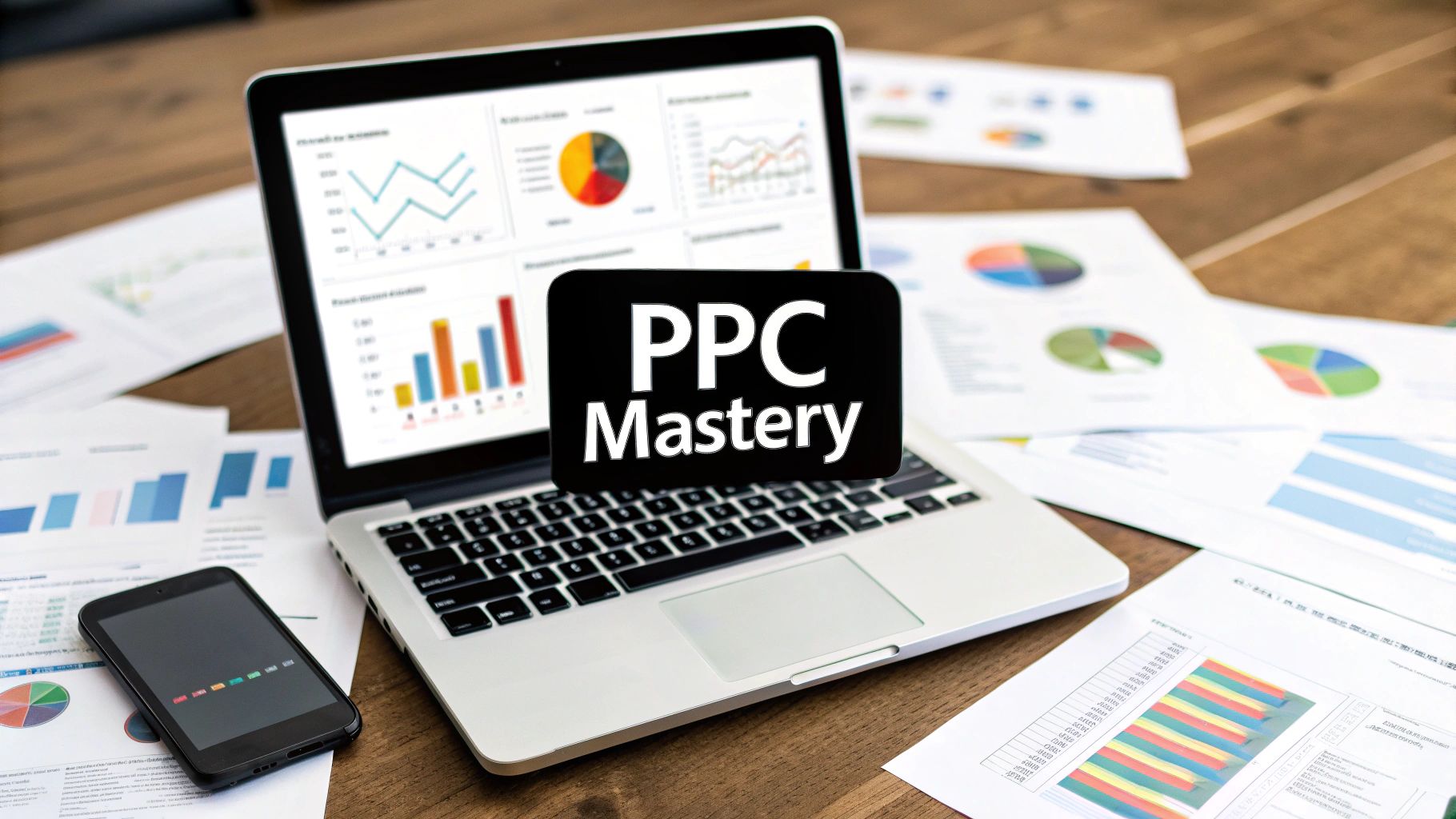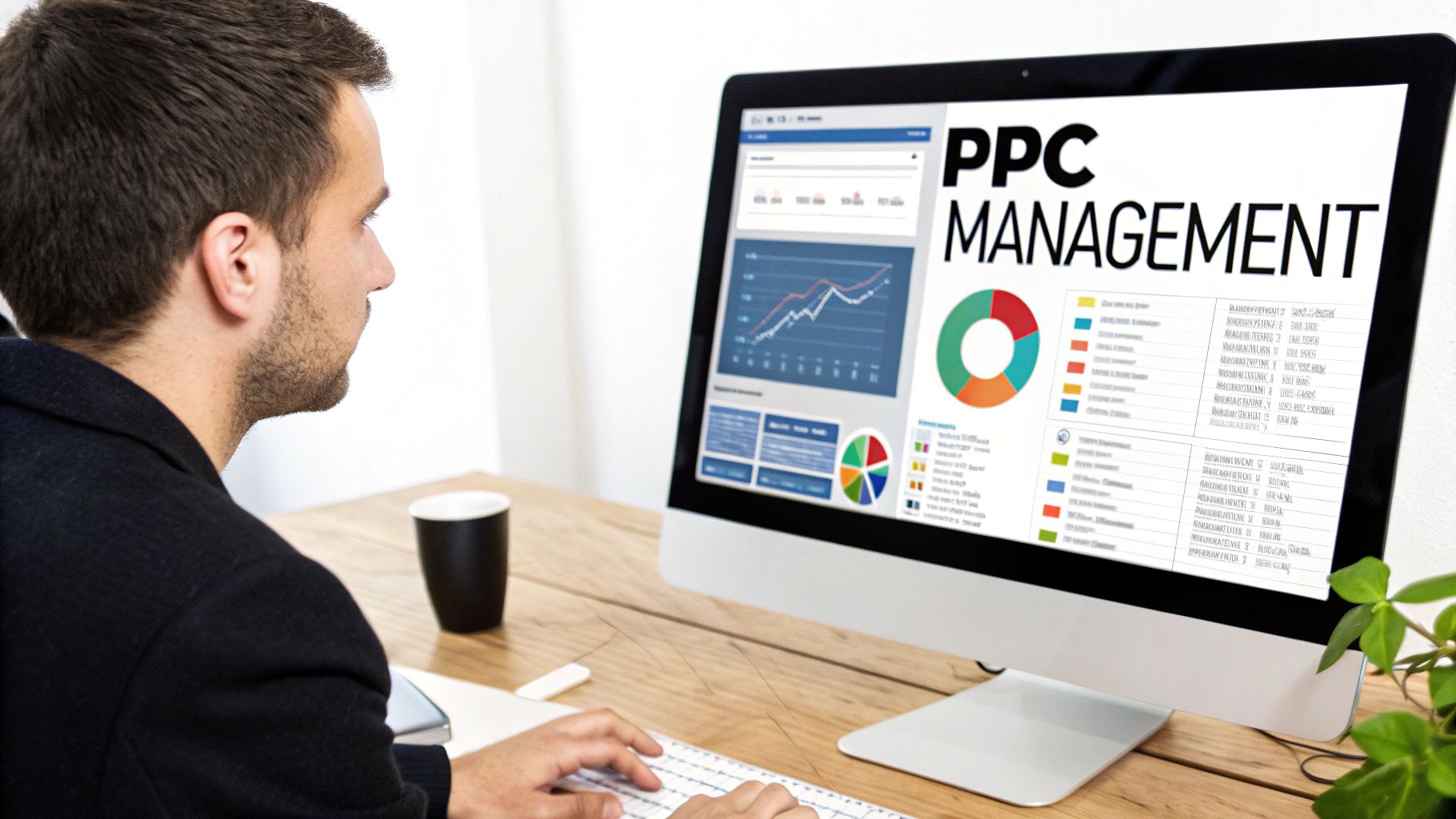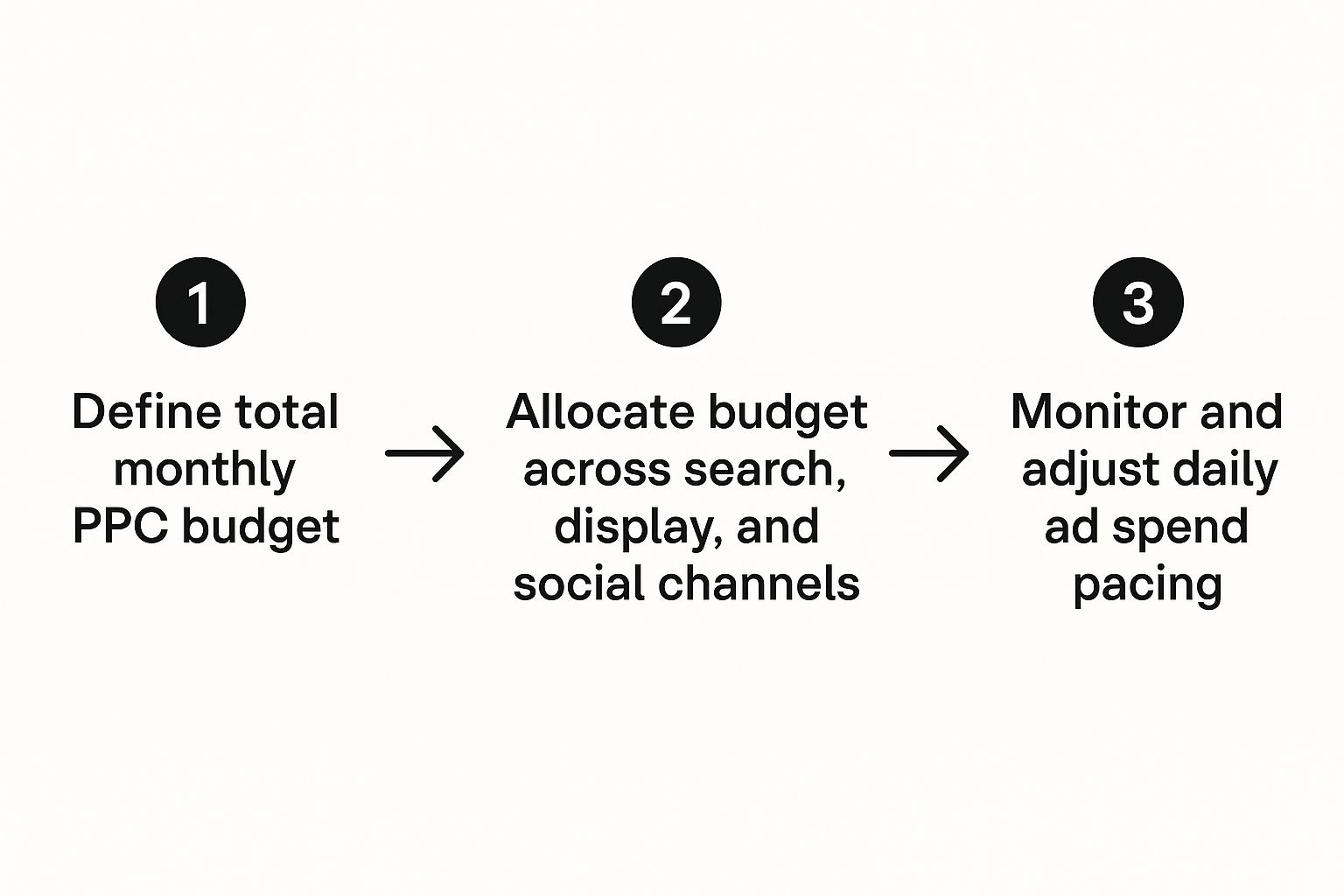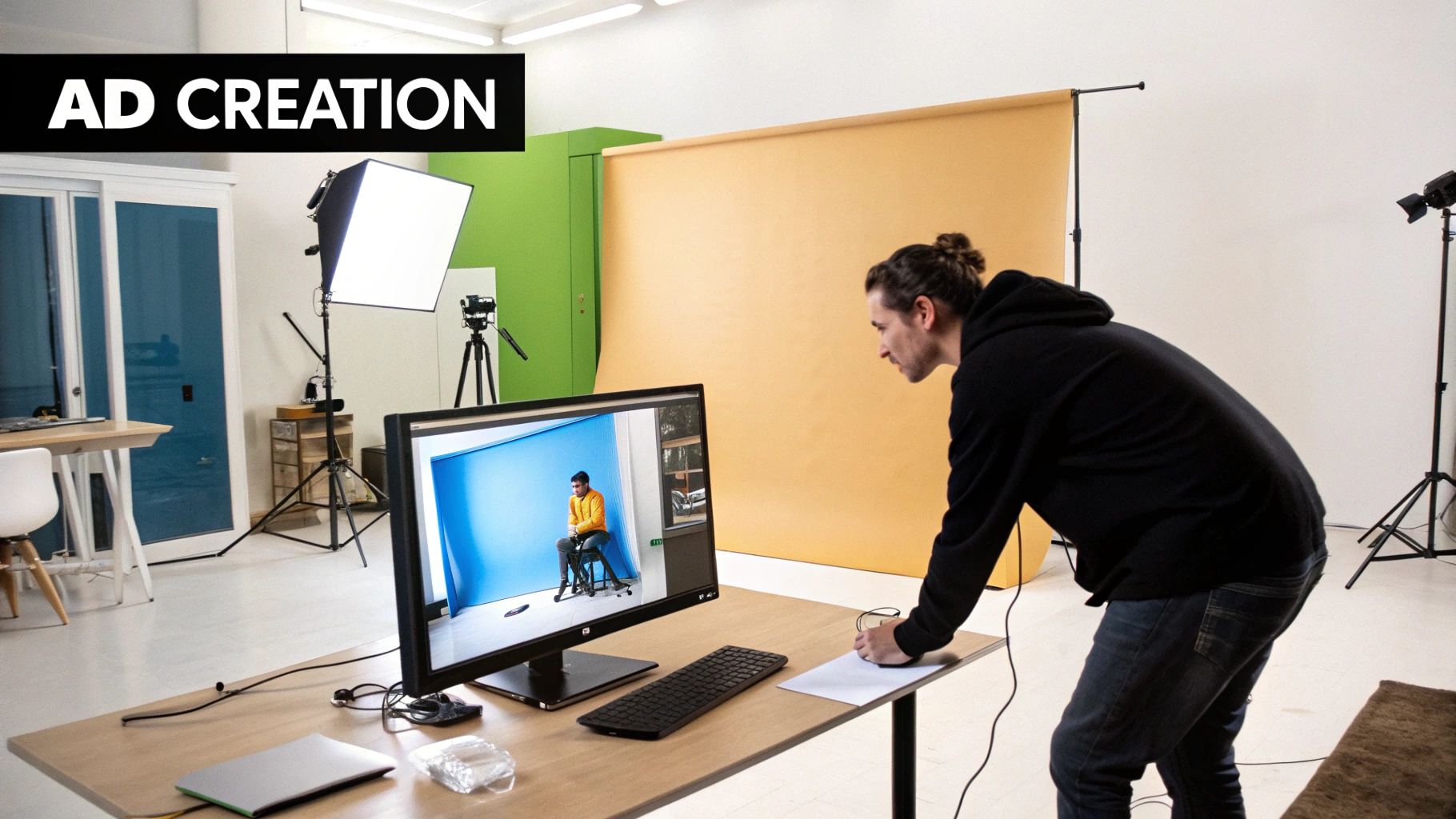August 22, 2025
A Guide to PPC Ad Campaign Management


Managing a PPC ad campaign isn't about flipping a switch and walking away. It’s the constant, hands-on work of steering your paid ads to squeeze every last drop of value out of your budget. Think of it as the difference between just running ads and actually winning with them.
Why You Can't "Set and Forget" PPC Anymore

Let's be blunt. Leaving a PPC campaign on autopilot is a surefire way to burn through your cash. In a market this crowded, active management is what separates the campaigns that fuel predictable growth from the ones that just drain your bank account.
An unmanaged campaign is a leaky bucket. It wastes money on clicks from people who were never going to buy, completely misses out on valuable keywords, and gets left behind when the market shifts. On the flip side, a well-managed campaign is a finely-tuned machine built for one thing: growth.
The Real Cost of Doing Nothing
The advertising game has gotten a lot more complicated. Platforms like Google Ads are more sophisticated, and your competitors are getting smarter. Just bidding on a handful of keywords with one ad variation simply doesn't cut it.
Without someone actively managing the account, you're setting yourself up for failure.
- Wasted Ad Spend: Your budget gets chewed up by irrelevant clicks that have zero chance of converting.
- Missed Opportunities: Your competitors are grabbing all the new, high-intent keywords while you're standing still.
- Performance Decay: The ad that killed it last month is now stale. Ad fatigue sets in, and platform algorithms are always changing.
This is exactly why a hands-on approach is mandatory. When done right, PPC management turns your ad spend from a cost center into a powerful investment. The numbers don't lie—businesses can earn an average of $2 for every $1 spent on PPC, and some see returns as high as 800%. It’s no wonder 93% of marketers swear by it. With Google Ads being the primary tool for 98% of US marketers, getting this right is non-negotiable. You can dig into more of these stats over at blog.coupler.io.
The goal isn't just to run ads. It's to build a system that generates a predictable, scalable return that actually helps you hit your business goals, whether that's more leads or more online sales.
Getting Out of the Weeds and Into Strategy
So, what does great campaign management actually involve? It’s a constant loop: plan, execute, measure, and refine. It's about letting the data guide your decisions instead of just guessing what might work.
Think about all the tedious, tactical work—manually adding negative keywords, fiddling with match types, running search query reports. It’s all crucial, but it's also a massive time-suck.
This is where automation tools like Keywordme are a game-changer. By handling the repetitive grunt work, they free you up to focus on the high-level strategy that truly drives results. Instead of being buried in a spreadsheet, you can start asking the big questions. Should we test a new ad angle? Is our landing page converting as well as it could? How can we steal market share from our biggest competitor?
That's where the real magic happens.
Laying the Groundwork for a Killer Campaign

Diving headfirst into a PPC campaign without a solid plan is a classic rookie mistake. It’s like trying to build a house without a blueprint—you might get some walls up, but you'll end up with a wobbly, expensive mess that needs to be torn down. Trust me, the real work of a winning campaign happens long before you even think about writing an ad.
This initial planning phase is absolutely critical. It’s where you decide what "success" actually means for your business and sketch out the map to get there. Skipping this part is probably the single biggest reason so many campaigns burn through cash without delivering a real return.
Nail Down Your Campaign Goals
First things first: what are you actually trying to accomplish? And no, "get more traffic" doesn't count. That's a vanity metric. Your goals need to be concrete, measurable, and tied directly to your business's bottom line.
So, what's the end game?
- Are you hunting for leads? If so, you'll be obsessing over your Cost Per Acquisition (CPA) and the number of qualified form fills you get each month.
- Trying to drive e-commerce sales? Then your world revolves around Return On Ad Spend (ROAS) and total transaction value.
- Just need to build brand awareness? Success here looks like a ton of impressions, a wide reach, and solid engagement metrics.
Your answer to this question changes absolutely everything—from the keywords you target and the ads you write to the landing pages you build. Without this clarity, your entire ppc ad campaign management strategy is just guesswork.
A campaign without clear goals isn't a strategy; it's an expensive hobby. You have to know what you're aiming for to ever have a chance of hitting it.
Get Inside Your Customer's Head
Okay, you know the "what." Now it's time for the "who." Who are you actually trying to reach? What problems are they desperately trying to solve? What exact phrases are they typing into Google at 2 AM?
This isn’t about guessing. It's about becoming a detective. Dig into customer surveys, grab your sales team for a coffee and pick their brains, and get your hands dirty with your existing customer data. Build out a detailed buyer persona that feels like a real person, not just a list of demographics.
Understanding their pain points is the secret sauce. It’s what lets you write ad copy that stops them in their tracks and choose keywords that attract people who are ready to buy. Remember, you're not just pushing a product; you're offering a solution to a real person's problem.
Set a Realistic Budget and Pinpoint Your KPIs
Let's talk money. Your budget has a direct impact on your campaign's potential. A huge mistake I see all the time is people spreading a tiny budget way too thin across dozens of campaigns and hundreds of keywords. Don't do that.
Start with a focused, surgical approach. Put your money where you think it'll make the biggest splash first. PPC platforms like Google Ads are massive auctions, so your budget has to be competitive enough to even get in the game.
Next, use your goals to define your Key Performance Indicators (KPIs). These are the specific numbers you'll be watching like a hawk every single day.
Your go-to KPIs will likely include:
- Click-Through Rate (CTR)
- Cost Per Click (CPC)
- Conversion Rate
- Cost Per Acquisition (CPA)
- Return On Ad Spend (ROAS)
Setting realistic targets for these KPIs from the get-go gives you a benchmark to measure against. This data-first mindset is the heart and soul of smart ppc ad campaign management. For a deeper dive, check out our guide on building the perfect PPC campaign checklist.
Structure Your Campaigns for Success
A messy campaign structure is a silent budget killer. It tanks your Quality Scores, serves up irrelevant ads, and makes optimization an absolute nightmare. A logical structure isn't just nice to have; it's essential.
Think of it like an organized filing cabinet.
- Campaigns: These are your main drawers. You'll organize them by product line, service type, or even location (e.g., "Men's Running Shoes - USA").
- Ad Groups: These are the folders inside each drawer. Each ad group should contain a small, tightly-themed cluster of keywords (e.g., "Nike Running Shoes," "Trail Running Shoes").
- Keywords & Ads: These are the documents in the folders. The ads inside an ad group should be hyper-relevant to the specific keywords in that same group.
This tight-knit structure means that when someone searches for "Nike running shoes," they see an ad that speaks directly to them—not a generic ad about shoes. The ad platforms reward this relevance with lower costs and better ad rankings. Using a tool like Keywordme from the start can help you map all this out visually, ensuring you're building on a rock-solid foundation.
Mastering Keyword Research and Selection
Let's be honest, keywords are the heart and soul of any PPC campaign. Get them right, and you're golden. Get them wrong, and you might as well be setting a pile of cash on fire. So, let’s dig in and go beyond just brainstorming to find the search terms that people actually use when they're ready to buy.
Solid ppc ad campaign management comes down to one thing: understanding what's going on in someone's head when they type into that search bar. It’s not just about what you’re selling; it’s about the problems, questions, and immediate needs that brought them to Google in the first place.
The Critical Role of Search Intent
Not every keyword is created equal—not by a long shot. The single most important factor is search intent, which is just a fancy way of saying "the why behind the search." Getting this right is the difference between attracting casual browsers and getting your ad in front of someone who’s already reaching for their wallet.
Here’s how it usually breaks down:
- Informational Intent: People are just looking for answers. Think "how to fix a leaky faucet" or "best running shoes for flat feet." These are great for bringing people to your blog, but they aren’t typically looking to buy right now.
- Commercial Intent: Now we're getting warmer. These searchers are actively comparing their options. You'll see searches like "Keywordme vs competitor" or "running shoe reviews." They're in the research phase but moving closer to a decision.
- Transactional Intent: This is the sweet spot. The user is ready to pull the trigger. They’re typing in things like "buy Nike Pegasus 41" or "emergency plumber near me." These keywords have the highest potential to convert, and it's where a good chunk of your ad budget should be focused.
By zeroing in on transactional and high-commercial intent keywords, you ensure every dollar you spend has the best possible chance of making a real impact on your bottom line.
Digging for Gold with Long-Tail Keywords
It’s tempting to go after the big, high-volume keywords like "running shoes," but that’s often a very crowded and expensive game to play. The real magic often happens in the long-tail keywords.
These are the longer, more specific phrases people use, like "men's waterproof trail running shoes size 11." Sure, they have less search volume on their own, but they pack a serious punch. Why? Because that level of specificity signals a user who knows exactly what they want. This almost always leads to higher conversion rates and, often, a lower cost-per-click (CPC). Of course, a key part of this is knowing how to find keywords search volume so you can properly evaluate which of these long-tail terms are worth targeting.
This infographic gives you a great visual of how to think about your budget once you have your keywords locked in.

As you can see, setting a total budget is just the start. The real strategy lies in how you slice up that pie and then constantly tweak your allocations based on what the performance data is telling you.
Wielding Match Types to Control Your Spend
Okay, so you’ve got your killer keyword list. You can't just toss it into Google Ads and hope for the best. You need to tell the platform how precisely a user's search should align with your keyword. This is where keyword match types come in, and they are one of your most powerful levers for controlling costs and boosting relevance.
Keyword Match Types and When to Use Them
Picking the right match type is crucial. It dictates how much freedom Google has to match your keywords to user searches, directly impacting both your reach and your budget. Here’s a quick-and-dirty guide to the big three.
As you can see, each has its place. Broad Match can be great for casting a wide net initially, while Exact Match is for when you're ready to double down on your proven winners.
Getting match types right is fundamental to good campaign hygiene. Misusing them is like trying to catch a specific type of fish with a net that has giant holes in it—you'll get a lot of stuff you don't want and miss what you were actually after.
This is an area where a tool like Keywordme can be a game-changer. It digs into your search term reports and provides smart suggestions on the right match types, helping you graduate promising broad match queries into more tightly controlled phrase or exact match keywords. If you want to dive deeper, you can learn more about Google Ads keyword match types in our detailed guide.
Just as important is building out your negative keyword list. These are the terms you explicitly forbid Google from showing your ads for. For example, if you sell high-end running shoes, adding "cheap" and "free" as negatives is a no-brainer. It stops you from wasting money on clicks from bargain hunters who were never going to buy from you anyway. Keywordme helps automate this tedious work by flagging and adding irrelevant search terms to your negative lists, making sure your ad spend stays focused on people who can actually become customers.
Making Ads and Landing Pages People Actually Want to Click

Alright, you've done the hard work with keywords and got your prospect's attention. Now for the moment of truth. Getting that click is just the first handshake—it's your ad copy and landing page that actually seal the deal.
Think of this as a critical handoff. Your ad makes a promise, and your landing page has to deliver on it. Any disconnect here is the fastest way I know to torch your conversion rates and waste a perfectly good budget.
Writing Ad Copy That Begs to Be Clicked
Let’s be real: your ad is fighting for air on a crowded page. Being bland is a death sentence. Your headlines and descriptions need to speak directly to the user’s problem, right then and there.
Don't just list what your product does; sell the feeling of the solution. Someone searching for "emergency roof repair" isn't just buying shingles; they're buying peace of mind and a dry living room. Your ad has to echo that feeling.
A few formulas I’ve seen work time and time again:
- Problem/Solution: "Leaky Roof? Get a Free 24/7 Quote in Minutes."
- Benefit-Focused: "Finally Get a Good Night's Sleep. Soundproof Your Windows."
- Social Proof: "Join 50,000+ Happy Customers. Start Your Keywordme Trial."
And please, always include a crystal-clear call-to-action (CTA). Tell people exactly what to do next—whether it's "Shop Now," "Book a Demo," or "Download the Guide." Don't make them guess.
Using Ad Extensions to Own More Real Estate
Ad extensions are your secret weapon. They make your ad bigger, more useful, and way more clickable. These are the extra snippets of info—like a phone number, your address, or quick links to specific pages—that Google can show with your ad.
Honestly, not using them is just leaving money on the table. They boost your ad's visibility, improve your click-through rate (CTR), and give searchers more reasons to pick you over the competition. It's like a free upgrade for your ad.
The Landing Page: Where the Magic Happens (or Doesn't)
You got the click. Awesome! But where are you sending them? If the answer is "my homepage," we need to have a serious talk. A dedicated landing page, designed for one single action, is non-negotiable for a serious campaign.
The page has to be a seamless continuation of your ad. If your ad screams "50% Off Running Shoes," that sale better be the first thing they see. This is called message match, and it's everything for building trust and stopping people from hitting the back button.
Your landing page has one job: get the conversion. That’s it. Ditch the distracting navigation menus, social media icons, and anything else that doesn't push the visitor toward that one goal.
A huge part of this is designing effective lead capture forms. Keep them short, simple, and only ask for the info you truly need to get the ball rolling.
The money pouring into paid search is staggering. The global market is set to hit $351.5 billion in 2025, with the U.S. alone making up $154.78 billion of that. With that kind of competition, you can't afford to fumble the conversion on your landing page.
So, what does a high-converting landing page actually include?
- A Killer Headline: Restate the main benefit from your ad. No surprises.
- A Clear Offer: In a few seconds, they should know what you're offering and why it's great.
- Engaging Visuals: A high-quality photo or a short video showing the result is perfect.
- Skimmable Benefits: Use bullet points. People scan, they don't read novels.
- One Big, Obvious CTA: A brightly colored button with action-focused text like "Get My Free Quote" works wonders.
Optimizing and Scaling Your Campaigns for Growth
Getting your PPC campaign live is really just hitting the starting line. The real work—and the real money—is made in the weeks and months that follow. A great campaign is never a "set it and forget it" machine; it's something you have to constantly tune, analyze, and refine. This is where the ongoing cycle of optimization and scaling takes over.
Think of yourself as a data detective. Your job is to sift through performance metrics, find the clues that tell you what's actually working, and cut out what’s just burning through your cash. It's all about making a series of small, smart tweaks that add up to massive growth over time.
The Never-Ending Cycle of Testing and Learning
The secret to long-term PPC success is pretty simple: never stop testing. Seriously. What worked like a charm last month might totally bomb this month. The only way to stay ahead is to adopt an "always be testing" mindset. This isn’t about throwing spaghetti at the wall to see what sticks; it's about methodical, data-backed experimentation.
And you can't just test random things. You need a structured approach to figure out what truly makes a difference.
- A/B Test Your Ad Copy: Pit two different headlines against each other. Does a benefit-driven headline beat one that creates a sense of urgency? The data will tell you the real story.
- Experiment with Landing Pages: Try a different color for your call-to-action button. Test a shorter lead form. You'd be amazed how even tiny tweaks on your landing page can lead to big jumps in conversion rates.
- Play with Bidding Strategies: Are you getting better results with manual CPC, or is it time to let a smart bidding strategy like Target CPA take the wheel? You won't know for sure until you test it.
The golden rule here is to only change one variable at a time. If you change your headline, ad description, and landing page all at once, you'll have absolutely no idea which change was responsible for the results, good or bad.
Mastering Your Bids and Budget
Managing your bids effectively is a constant balancing act. If you bid too low, your ads get buried and no one sees them. Bid too high, and your cost-per-acquisition (CPA) will go through the roof, eating away at your profits.
This is where you need to watch your metrics like a hawk. Keep a close eye on your impression share, top-of-page rate, and, most importantly, your conversion data. Are your best-performing keywords consistently getting the exposure they deserve? If not, it might be time to gently nudge those bids up.
On the flip side, if a keyword is getting a ton of clicks but zero conversions, it's time to either slash the bid or just pause it. Smart bid management isn't about winning every single auction; it's about winning the right auctions that actually lead to profitable business.
Optimization is really just about doing more of what works and less of what doesn't. It sounds simple, but it takes a ruthless commitment to following the data, not your gut feelings.
The dynamics of campaign performance are always shifting. Recent data shows the average cost per lead on Google Ads has inched up by 5.13% to $70.11. But here's the interesting part: even with those rising costs, 65% of industries actually saw their conversion rates improve. This tells us that smarter, quality-focused strategies are winning out over just chasing cheap clicks.
Knowing When and How to Scale
Once you have a campaign or an ad group that's really humming along—delivering a consistent, positive return on ad spend (ROAS)—it's time to hit the gas. But scaling isn't as simple as just jacking up the budget. If you do it recklessly, you can quickly break a perfectly good campaign.
To effectively scale, you need to implement robust marketing campaign optimization strategies. This means having a clear plan for how you'll expand your reach without torpedoing your profitability.
Here’s how to scale your winning campaigns the smart way:
- Increase the Budget Gradually: Don't double the budget overnight. That’s a recipe for disaster. Instead, increase it by 15-20% at a time and give the platform's algorithm a few days to adjust and learn. Keep a close eye on your CPA to make sure it stays in a healthy range.
- Expand Your Keyword Targeting: Dive into your search term report. It's a goldmine for finding new, high-intent keywords that are already driving conversions. Add these as new exact or phrase match keywords to capture more of that proven traffic.
- Explore New Channels or Audiences: Is your search campaign a massive success? Maybe it's time to test out a Display campaign using remarketing audiences or even dip your toes into Performance Max to find new pockets of customers you hadn't reached before.
Scaling is an art that blends data analysis with a bit of strategic risk-taking. This is where a tool like Keywordme becomes a game-changer. Instead of getting lost in endless spreadsheets trying to find expansion opportunities, Keywordme helps you spot winning search terms and scale them into new ad groups with just a few clicks. It cuts out the manual grunt work of scaling so you can focus on making the big-picture decisions that drive real, sustainable growth.
To dig deeper, check out our pro guide on how to improve Google Ads performance.
Got PPC Questions? We've Got Answers.
Diving into paid search can feel like you've been dropped in a foreign country without a map. You're suddenly swimming in acronyms, weird metrics, and a million different opinions on what to do next. It's totally normal to feel a bit lost.
So, let's clear things up. We've pulled together some of the most common questions we get about managing PPC ad campaigns and are giving you the straight-up, no-fluff answers.
How Long Does It Really Take to See PPC Results?
This is the million-dollar question, isn't it? The honest, expert answer is: it depends.
You’ll see activity—impressions, clicks, a trickle of traffic—almost the second you launch. That part is instant. But seeing a real, profitable return on your investment? That’s a different story. You've got to play the long game.
You should give yourself a solid 3-6 months to really know what's working. Think of the first month as pure data gathering. You're learning what your audience actually searches for, not what you think they search for. After that, you'll start testing, tweaking, and refining. Things like how competitive your market is, your budget, and how well you built the campaign from the start will all shift that timeline.
What's a Good Click-Through Rate for PPC, Anyway?
A "good" Click-Through Rate (CTR) is a bit of a moving target. It changes dramatically depending on your industry, the keywords you're bidding on, and where your ad shows up on the page.
For a standard Google Search campaign, if you're hitting anywhere in the 2-5% range, you're in a decent spot. Anything over 5% and you're probably doing a fantastic job.
But let me be crystal clear: CTR means nothing if the clicks aren't converting. A super high CTR with a zero conversion rate is a massive red flag. It usually means there's a huge disconnect between your ad's promise and your landing page's reality.
It's all about the quality of the click, not just the quantity.
How Often Should I Actually Check My PPC Campaigns?
This is a classic. You need a rhythm that keeps you on top of things without making you go crazy with over-optimization.
Here’s a simple schedule I've used for years:
- Brand new or high-budget campaigns: Check in daily for about 15 minutes. You're just looking for fires to put out—like a sudden jump in your cost-per-click (CPC) or an ad getting disapproved out of the blue.
- Mature, steady campaigns: Once a campaign is humming along nicely, checking in 2-3 times per week is perfect. This is for your regular maintenance, like tweaking bids or combing through search term reports for new ideas.
The biggest rookie mistake is making huge, reactive changes every single day. The algorithms need time and data to do their job, and you'll just keep resetting their learning process if you're constantly yanking the wheel.
What's the Single Biggest Mistake Beginners Make?
Oh, this one's easy. It’s completely ignoring negative keywords.
When you don't build a strong negative keyword list, you're basically telling Google it's okay to waste your money. Your ads end up showing for all kinds of junk searches from people who were never, ever going to buy from you. It’s like throwing cash straight into a bonfire.
Another huge, conversion-killing mistake? Sending all your traffic to your homepage. Please, don't do this. Every ad needs its own dedicated, laser-focused landing page. It should be built for one thing and one thing only: getting that conversion. It’s a simple fix that makes a world of difference.
Ready to stop guessing and start streamlining your campaign workflow? Keywordme handles the tedious work—like cleaning up search terms and finding new, proven keywords—so you can actually focus on strategy. Start your free 7-day trial today!


.svg)